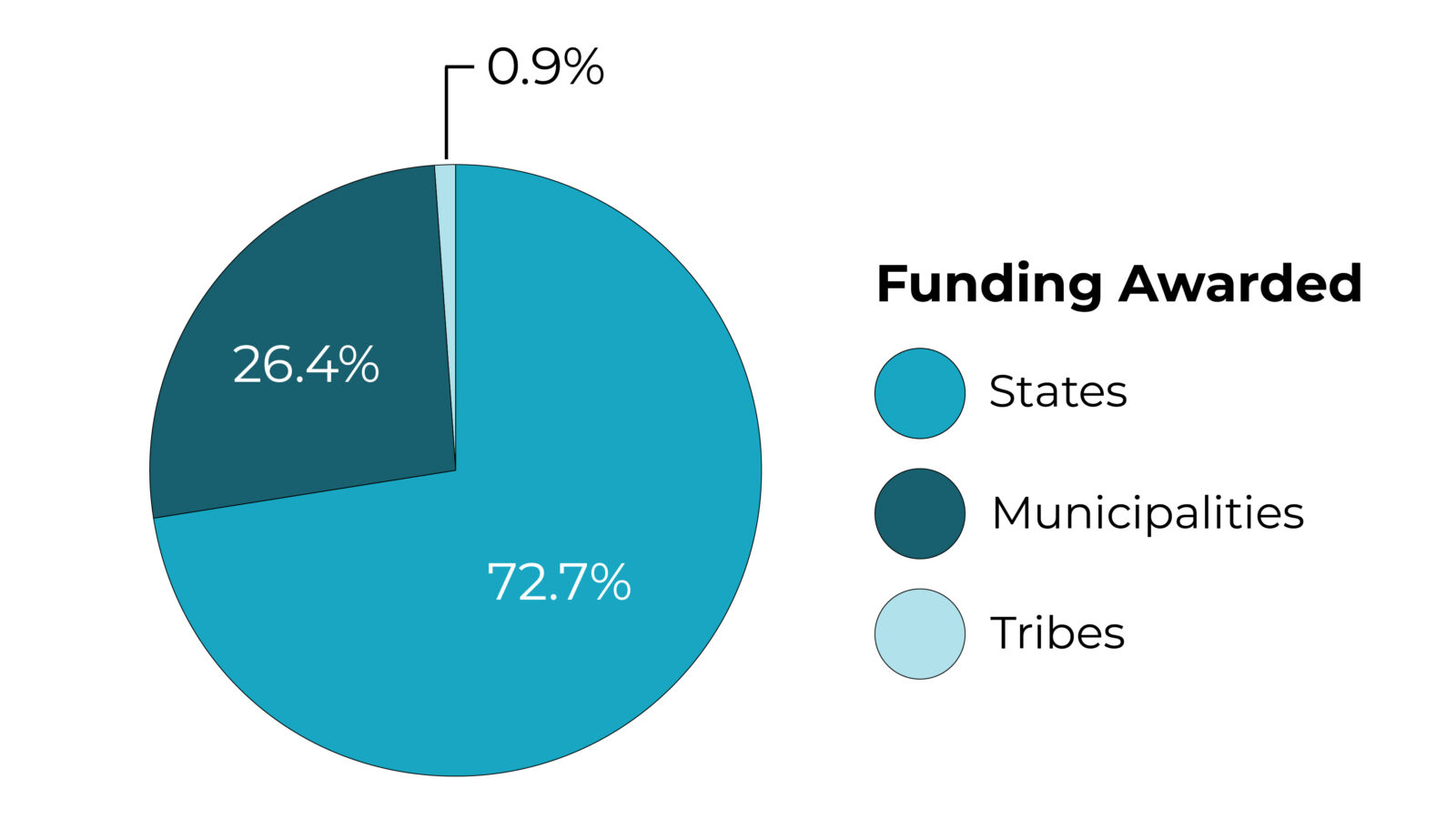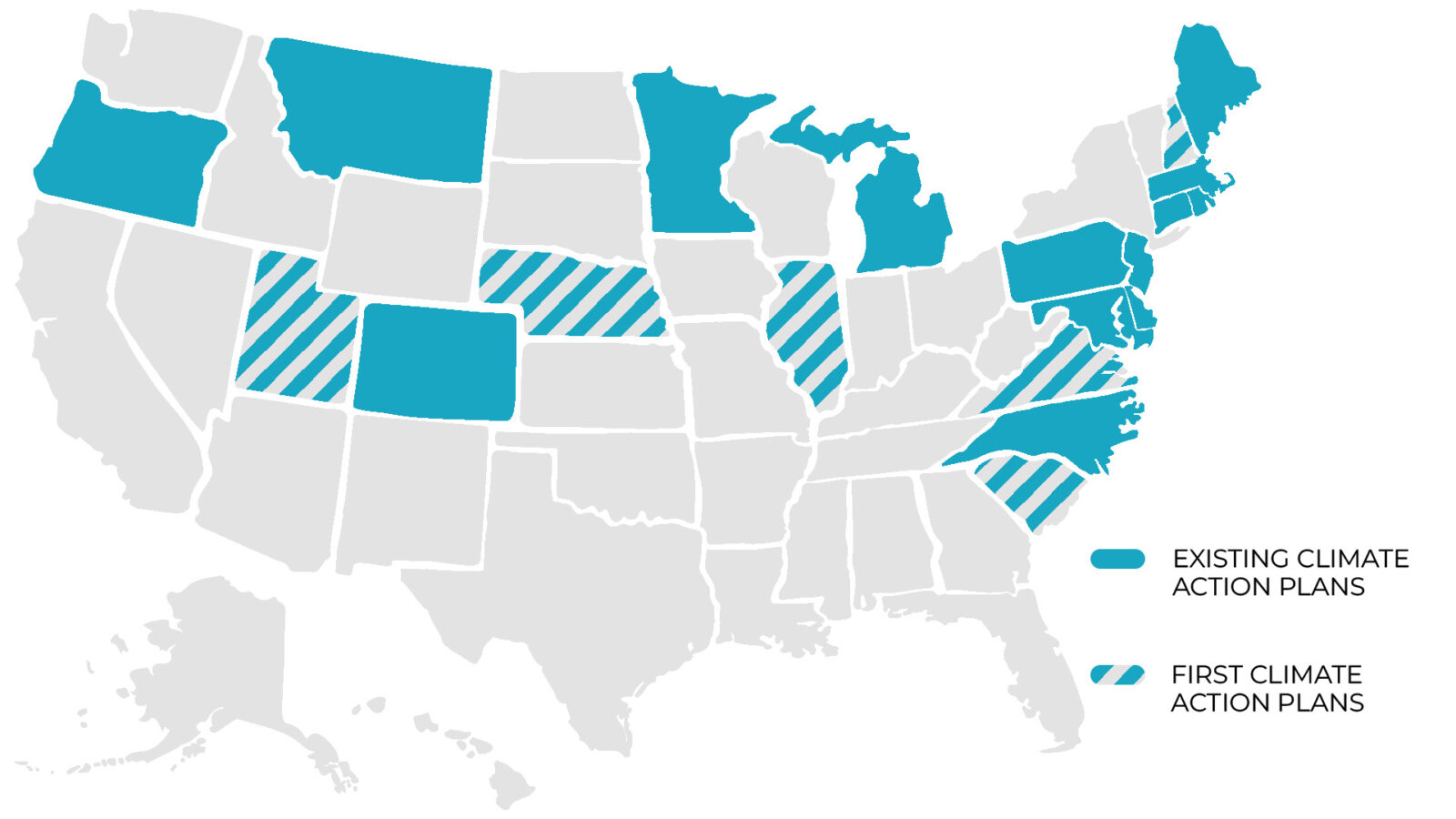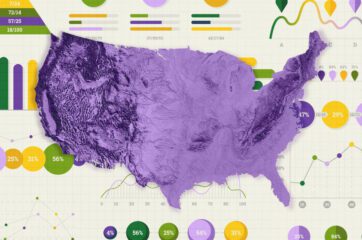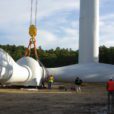Authors
Ruby Wincele, Kristen Soares, and Greg Casto
This week, the U.S. Environmental Protection Agency (EPA) announced the state, local, and Tribal* recipients for Implementation Grants from the Climate Pollution Reduction Grant (CPRG) program established in the Inflation Reduction Act. In total, the recipients were awarded more than $4.3 billion in grants to implement climate change solutions that were proposed in their Priority Climate Action Plans (PCAP), submitted to the EPA in March as part of the first stage of the CPRG program.
Climate XChange, along with RMI and Evergreen Collaborative, conducted an analysis of these 47 PCAPs developed by 45 states, Puerto Rico, and the District of Columbia. Now, Implementation Grants have been awarded to 20 of those states, either individually or as part of a multi-state coalition.
This funding represents the biggest federal investment in state climate policy in U.S. history and is expected to have significant impacts on greenhouse gas emissions, public health, conservation, and the economy. Here are our key takeaways from the EPA’s announcement.
*The award recipients discussed in this article are for CPRG’s general competition, which was open to states, municipalities, Tribes, Tribal consortia, and territories. There is a separate competition open only to Tribes, Tribal consortia, and territories, which has yet to be announced and is anticipated sometime this summer.
States were awarded $3.13 billion of the $4.3 billion total
The EPA awarded Implementation Grant funding to 25 selected applications from the planning stage of the CPRG program. Thirteen of those awards were for state applications, 11 for municipalities, and one for a Tribe. Eight awards were for coalition-based applications, which included a variety of stakeholders as co-applicants, including state agencies, cities, counties, regional governmental councils, metropolitan planning organizations, air quality management districts, and governor’s offices. The award amounts vary significantly, from $3 million for the Hudson Valley Regional Council’s landfill emissions program to just under $500 million to California’s South Coast Air Quality Management District’s transportation emission reduction measures.

The 13 state awards spanned 20 states, with nine awards for individual state applications and four for coalition-based applications, all of which were Eastern state coalitions.
Some states were recipients of multiple awards. Of the 13 state awards, Connecticut, Maryland, and Virginia were each represented on two applications. A full list of selected applications can be found here.
Fourteen states have done climate planning before, six have not
The 20 states represented in the 13 state-level awards have varying levels of climate planning experience. Prior to developing a PCAP, 14 of these states had developed climate plans already, while six states — Illinois, Nebraska, New Hampshire, South Carolina, Utah, and Virginia — had not. Through both the PCAP and Implementation award processes, CPRG has provided a path for climate planning in states that have never had the opportunity, whether due to capacity constraints, political dynamics, or lack of funding. Even for the 14 states that had preexisting climate plans, this served as a refresher, with some states’ last climate plan developed as early as 2018.

Expected to reduce 809 million metric tons of CO2e by 2050
State-level awards are expected to reduce greenhouse gas emissions by 809 million metric tons (MMT) of carbon dioxide equivalent (CO2e) by 2050, representing around 83 percent of the total emissions reductions expected by CPRG Implementation Grants’ general competition. Michigan and Nebraska are driving forces, with their awards collectively accounting for 73 percent of states’ total reductions in climate pollution.
The emissions reductions from all state-level awards are equivalent to removing the carbon emissions from 159 million homes’ electricity use in one year, or the annual carbon sequestration of 944 million acres of U.S. forests.

Awards mostly address states’ highest emitting sectors
Despite being the third- and fourth-largest sources of emissions nationally, the industry and buildings sectors are the most represented on state-level awards, with seven awards each. Transportation and electricity, the two largest sources of emissions in the U.S., are covered by six awards each, followed by agriculture & natural and working lands (NWL) with five awards, and waste and materials management with four awards.
Good news: in the context of each state’s unique emissions profile, Implementation Grant awards largely address states’ highest emitting sectors.
Important to note here is that even though most of the highest-emitting sectors are covered by these awards, emissions in these sectors may not significantly decrease from Implementation Grants alone — nor is it clear if funding awards are proportionately allocated by sector based on their share of emissions.
Awards in 13 states address their highest emitting sector
For the 13 state-level awards, funding will address climate pollution from the highest-emitting sector in 13 out of 20 states. Transportation represents the largest source of emissions in seven of these states (Connecticut, Delaware, Illinois, Maryland, Minnesota, New Jersey, and Oregon), which are addressed in awarded projects like that of the multi-state Clean Corridor Coalition to deploy medium- and heavy-duty zero-emission vehicle charging infrastructure along Interstate-95, and that of Oregon to provide rebates for electric vehicles and charging infrastructure.
Pennsylvania’s award for Reducing Industrial Sector Emissions in Pennsylvania (RISE-PA) will create a statewide industrial decarbonization incentive program to address its highest-emitting sector. By targeting the industrial sector, Colorado, Illinois, and Utah’s awards also aim to address their largest source of emissions.
Michigan will receive nearly $130 million to decarbonize its electricity sector, which currently accounts for 35 percent of statewide emissions, aiming to meet its statutory requirement to generate 60 percent of electricity with renewable energy by 2030. Agriculture & NWL is responsible for the bulk of emissions in Montana and Nebraska, both of which received grants to implement climate-smart agriculture and forest management practices.
In states that were awarded multi-sector grants or multiple grants, the awards typically address sectors that make up the bulk of state emissions. Connecticut, for example, received funding from two multi-state coalitions that address its top two highest-emitting sectors: transportation and buildings. Minnesota’s Climate-Smart Food Systems project focuses on decarbonizing food systems by implementing climate-friendly practices across all stages of the food system, from food production to transportation and storage to disposal.
Awards in five states address their second-highest emitting sector
Maine, Massachusetts, New Hampshire, and Rhode Island — all states who are members of the New England Heat Pump Accelerator coalition to increase heat pump adoption — received implementation grant funding that addresses the second-highest emitting sector in each state: buildings.
Virginia, a member of the Atlantic Conservation Coalition, also received a state-based grant to address methane emissions from coal mines and landfills in the state. The state’s two awards collectively address the industrial, electric power, waste and materials management, and agriculture & NWL sectors. Although funding was not allocated to the state’s transportation sector, which makes up the largest share of emissions (35.6 percent), the award tackles the electric power sector, the next largest source of emissions.
Awards in two states do not address their top two highest emitting sectors
Members of the Atlantic Conservation Coalition received over $421 million in funding to implement projects that increase carbon sequestration of coastal habitats, wetlands, peatlands, and forests. In two member states, North Carolina and South Carolina, this represents the only CPRG implementation grant funding they have received. The agriculture & NWL sector accounts for the fourth and fifth largest sources of emissions in these states, respectively.
What Now?
Now that funding has been made available to these award recipients, states must shift focus to the on-the-ground work. In this phase, interagency collaboration, community engagement, and efficient project management are key components of what will make these investments as effective as possible.
For states that didn’t receive an Implementation Grant, this doesn’t mean the momentum on climate action should stop. States can still pursue other federal funding available to implement their climate measures — in fact, 41 out of 45 states that submitted PCAPs already identified alternative funding programs they can leverage to partially fund their climate strategies. The EPA also provides guidance on resources for other available opportunities. The CPRG program presents an opportunity for all participating states to reduce climate pollution, deploy clean energy technology, and create good-paying jobs.









